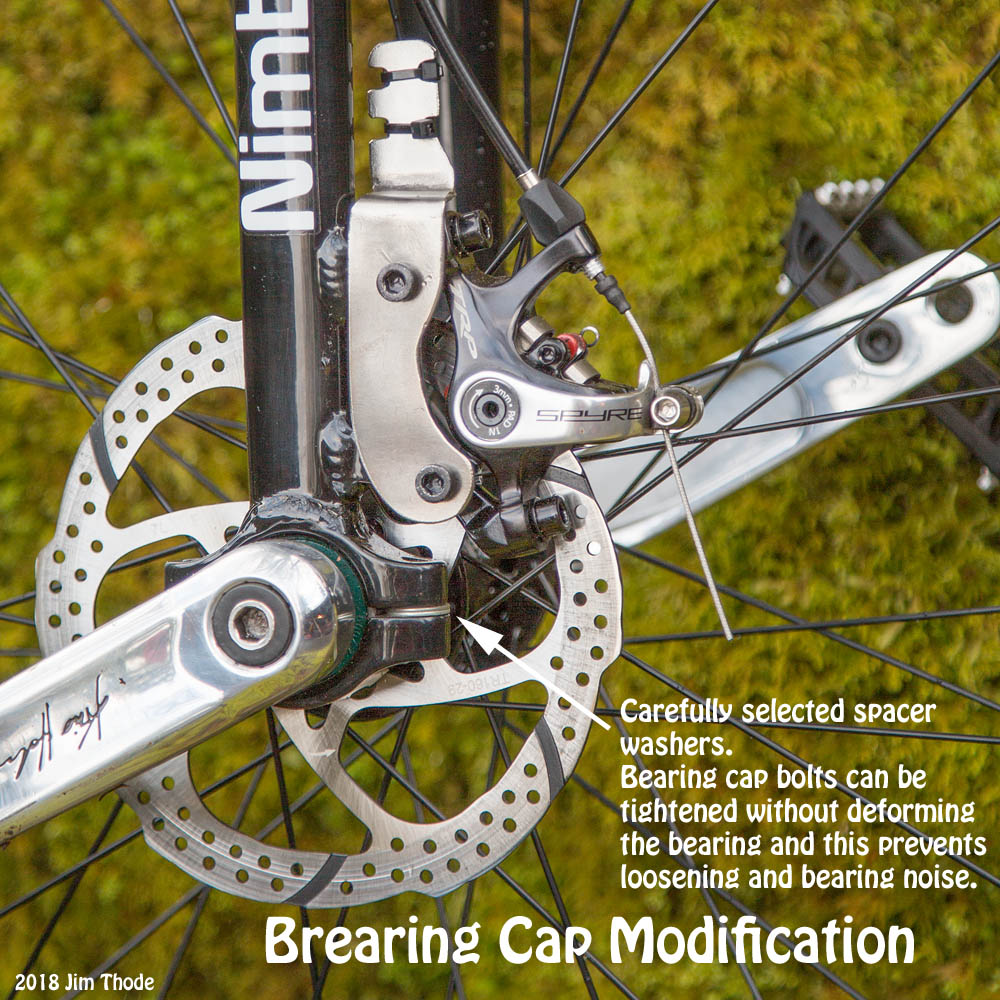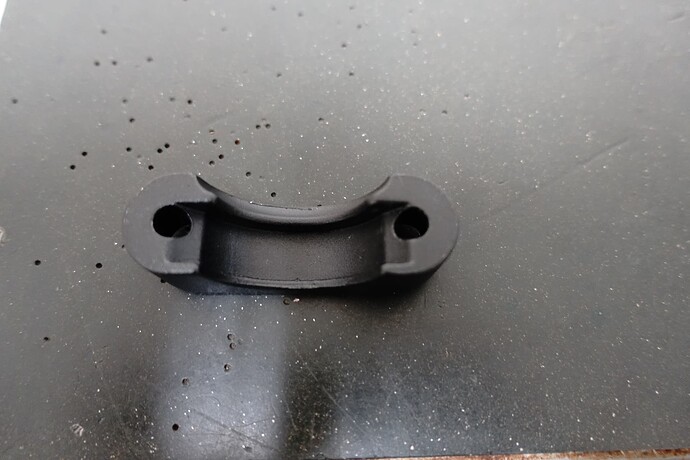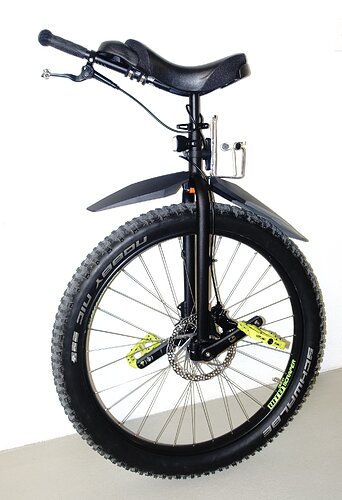That’s really nice. You can also go with a kh wheel, disc on the right side or for touring, like a qaxle wheel wirh the disc on the left side. It’s a good idea.
No, you can’t. It won’t fit EDB-Standard (External Disc Brake - Kris Holm crank mounted disc)
These are two left disc sockets, it is not intended for Kris Holm’s solution, it would have to be on the right in the direction of travel. Only with a special hub with 2 discs and a brake with 2 brake calipers (they actually exist) could you build a unicycle with double brakes. That probably wouldn’t be a bad idea from a stress perspective. But that’s not the idea of this fork. It’s actually nothing more than a fork with a built-in spare part. Here in this forum I have also read about broken brake sockets. Welding on a second brake base including the cable routing costs a small surcharge in relation to the price of the fork.
I tested the fork yesterday, equipped with a lightweight Nobby Nic 27.5x 3.0, WTB I40 rim, including Unicon handlebars, 180mm Shimano RT-56 disc and mt420 brake, it weighed 5.5 kg, without the brake and attachments I could break the 5kg limit.
But I also found one point of criticism with this fork:
Like many high-end forks, it is lighter and slimmer, but not necessarily better than cheap steel forks. As with other aluminum forks, this one also has an asymmetrical bearing shell, so the load point is not in the middle of the bearing. I’m not a fan of it because I rode such forks for many years. In order to get an internal width of the fork of at least 92mm, you have to use tricks, for example with oval fork tubes or asymmetrical bearing shells.
Disadvantage of thinner, oval tubes: Less lateral stability (flex?) Disadvantage of asymmetrical bearing shells: The wheels roll less well.
Actually, the standard of 100mm bearing distance is too narrow for 3", 3.25" tires, so you have to resort to these tricks. I have an aluminum fork from another fork manufacturer that uses round tubes and the bearing cups are symmetrical. There is only 80mm internal width, which is not enough for 3" tires. But this fork is much stiffer.
Well, I’m going to test this fork for a few months. I probably won’t bring it onto the market with an asymmetrical bearing shell, as the manufacturer will have to come up with something else, unless they supply me with suitable spacers that can be clamped between the shells. If it cannot be solved technically, I will have a sample made for my 120mm hub, where I automatically have 20mm more inner width and therefore automatically have 100mm inner width even with a simple fork with round tubes and normal bearing shells.
Bolt centered in the middle of bearings is much more important than symetrical or not shell….
absolutely agree, but it’s not. The holes for the screws are offset
So this is a wrong design, I asked Triton to modify same design some years ago and Dmitriy applied bolt centered (qu-ax had similar bad design on aluminum frame about 15 years ago)
Yes i know. I rode forks like this for a long time and was never really impressed.
Is this narrow fork for sale in your shop?
Is the yellow Fork, but is without Brake socket
So www.einradshop.ch why do unicycles still use out dated disc brake Caliper mounts?
Why do you feel this? One will fail that you need to have a spare?
Why not use a “post mount” mount or a dreaded flat mount?
All the best with your Uni Fork project.
Why should this be out of date? All unicycles have this IS mount. Postmount is a bad idea, QU-AX tried that. There is a greater risk that something will be wrong in the end. First of all, find a manufacturer who welds this bracket precisely and reliably - it’s not that easy. There are not many manufacturers that build unicycle forks and even fewer that are able to weld brake bases precisely and in the right place so that it fits. What exactly are your fears for the IS base? That there are no more IS-PM adapters? I just can’t understand what you mean.
Here is a Picture of a Fork with PM Socket it’s much clunkier. I definitely wouldn’t have a base like that welded on twice, it would look terrible
There is something that sucks about IS mount. It’s welded in place for a 160mm (or maybe even 140mm) disk, but then you have to adapt out to common modern disk sizes, which from the perspective of loadpaths/strength/forces makes no sense at all…
That particular execution wasn’t, but I think post mount is in general a more efficient and elegant design and (arguably) should be better from a tolerance perspective because you are (often) eliminating a spacer from the tolerance stack.
Flat mount is probably very, very close to clashing with the bearing holders, because it’s designed for tiny disks.
I can only answer this from the perspective of a unicyclist.
As already mentioned, QU-AX tried the PM bracket on the QX forks (see picture above). The only advantage was that in combination with 160mm discs you could screw the brakes on directly. For 180mm you also need an adapter. I think that you can correct more with the IS mount, because if something is wrong with the distance to the disc, you can either clamp a thin washer (there are special spacers) between the adapter or, in the worst case, sand the adapter a little. You don’t have this option with Postmount.
I also have postmount on my fat bike and I need an adapter for the 180mm brake disc there too. I think there is a reason why QU-AX switched from PM to IS.
The difference is that post mount is commonly welded in the position for the intended disk size with no adapter, on a DH MTB fork, you can find them in place for 200mm disks for example. As I mentioned, the execution on that old QX frame did not end up being great, but I don’t think that is conclusive proof that it doesn’t work on unicycles…
And the counterpoint to having more points of adjustments is always that there are also more places for it to be necessary, because there are more individual parts with individual tolerances. Most disk brakes have a few mm of adjustment side to side, that should really be sufficient normally.
I think that not having a manufacturer who is good at making post mounts is a perfectly valid reason to go with IS (because you will need different jigs/tooling than the post mount), but I agree with the sentiment that on a dream frame, I’d have post mount.
It’s always interesting to get new ideas. I could take this into account in a future series, or talk to fork manufacturers, so I would also consider CrMo in addition to aluminum for feasibility.
This is what the test unicycle assembled for me looks like with this fork for the winter months: With Unicon handlebar stem, 550lm dual LED lamp, dual cranks 125/145m, Shimano mt420 4 piston brake, 180mm disc, Bidon holder, SKS splash guard which can be dismantled in seconds ( I know, it doesn’t look pretty, but it’s very good). The weight is exactly 6.0 kg to the gram as shown - with a TPU tube it would be 100g lighter.
I can use a trick to make the ball bearings rotate easily: I fit washers between the bearing shells. I still have to experiment a bit with how much and what thickness it needs. Then the wheel should turn more easily, so I claim
Yes, carefully selected washers do make the bearing turn free and reduces the chance of loose bearing cap bolts.

Looks the same to me, I also installed 2 washers, but there is still some space, but 3 are too much. I’ll try it with matching spring washers
I’m guessing posting to the UK is still not possible?


